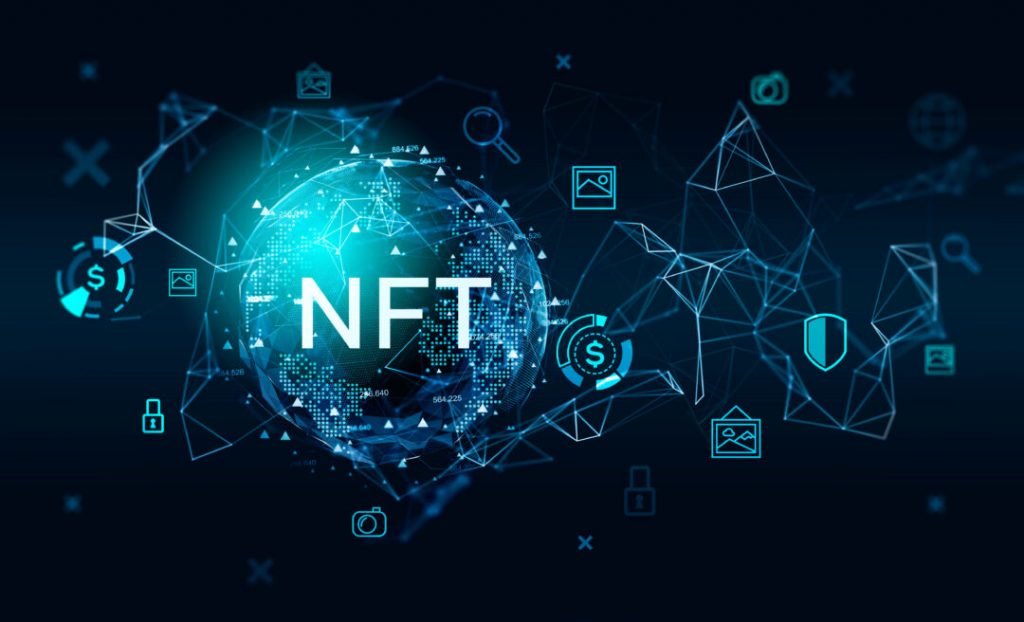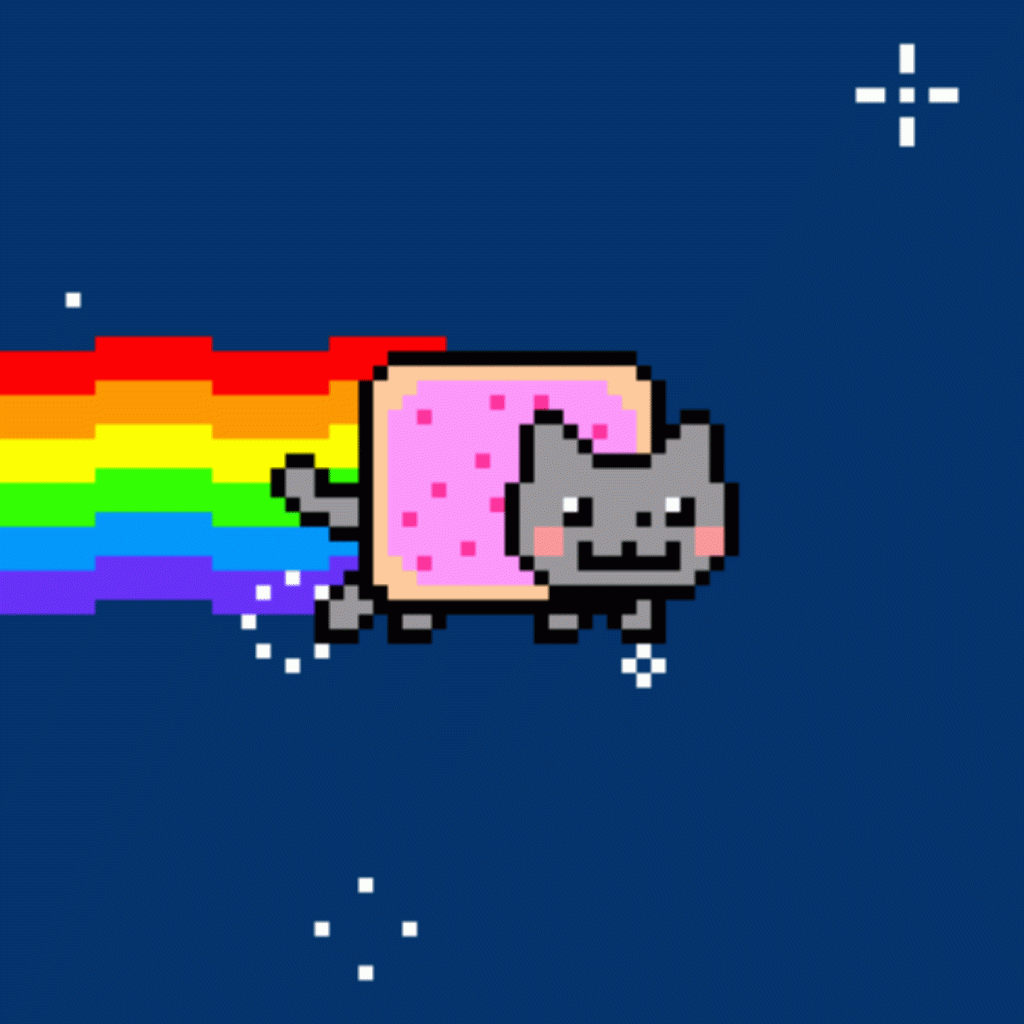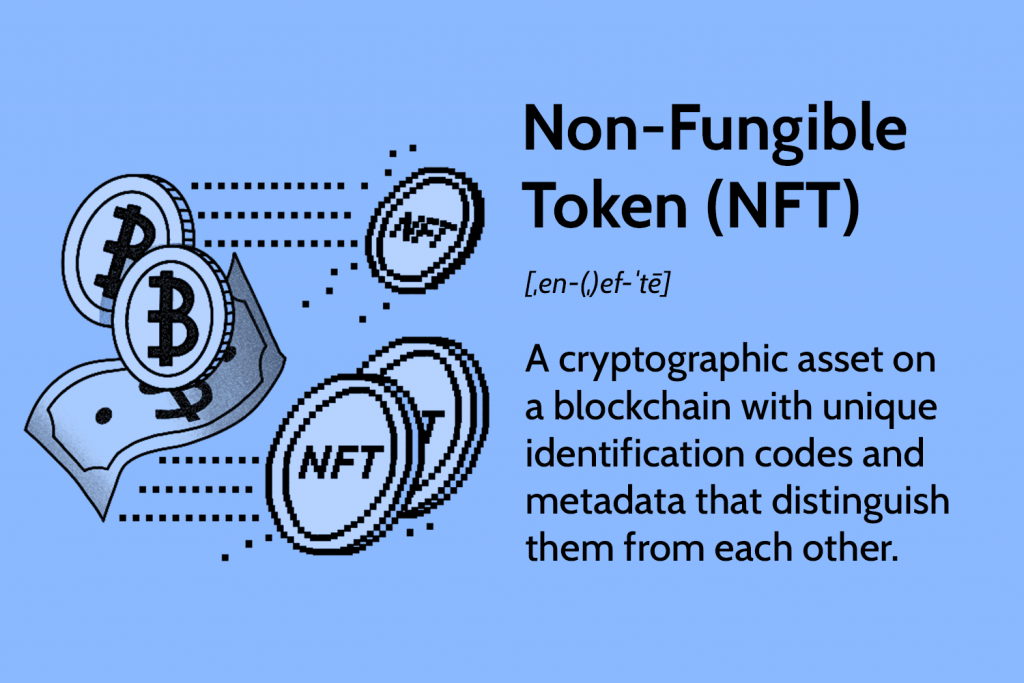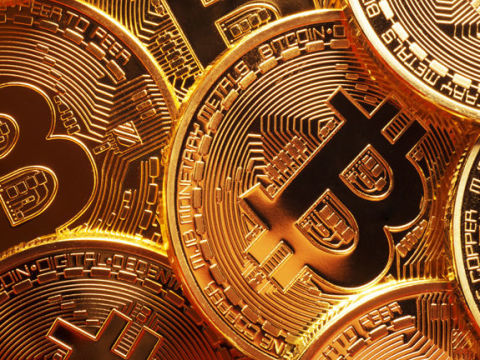ALL ABOUT NFT
What is an NFT, and how does it work?
Although the technology has been around for a while, NFTs took off in 2020 and have since become increasingly popular, especially in digital art. The NFT market has generated a lot of excitement but has also been criticized for being volatile, highly speculative, and vulnerable to fraud. In this article, we look at what you need to know about NFTs.

Meaning and definition of the NFT market
NFT stands for “non-fungible token.” Irreplaceable means that something is unique and cannot be replaced. In contrast, physical money and digital currencies are fungible, meaning they can be traded or exchanged for each other. Each NFT contains a digital signature that makes each one unique. NFTs are digital assets and can be photos, videos, audio files, or another digital format. Examples of NFTs include artwork, comic books, sports collectibles, trading cards, games, and more.
How do NFTs work?
Non-fungible tokens, or NTFs, are crypto assets on a blockchain—a distributed public ledger that records transactions. Each NFT contains unique identification codes that distinguish them from each other. This data makes it easy to transfer tokens between owners and verify ownership.
NFTs have a value determined by the market – i.e., supply and demand – and can be bought and sold like physical assets. NFTs are digital representations of help – and can also represent real-world items such as artwork and real estate. Tokenizing real-world tangible assets in this way is considered by some users to make their buying, selling, and trading more efficient and reduce the likelihood of fraud.
How do you buy NFTs?
The NFT market is considered high-risk, and its volatile highs and lows can discourage even experienced investors. If you are considering buying NFTs, it is essential to understand the process clearly. Let’s look at the steps involved:
Open a crypto exchange account
The first step is to open an account on a crypto platform or crypto exchange. A crypto exchange is an online platform where you can buy and sell different types of digital currencies. To purchase NFTs, you must create an account with your chosen venue. Other platforms offer other services, so it’s worth researching them to see which suits you best regarding features, costs, and ongoing support.
Open a crypto wallet.
A crypto wallet stores the keys that give access to your digital assets. Users are assigned a unique seed phrase called recovery to access their wallet. Keeping your seed phrase secure is essential – without it, you’ll lose access to your wallet.
Wallets can be hosted on an exchange or may operate independently. You are responsible for your wallet and private keys. If they work independently, talk hosts your digital wallet and the business acts as an intermediary for transferring digital currency. This company holds your private keys and is responsible for keeping your assets safe.
On the other hand, if you want to buy and sell NFTs without the involvement of a third party, you need a wallet that is directly connected to the blockchain.
This allows currency to be transferred directly between people using the public key. The two types of wallets available are called “hot” or “cold”:
Hot wallets are:
- Software, web-based wallets.
- Known as a desktop or mobile app, in-browser extension, or both.
- It is more vulnerable to cyber attacks than cold wallets.
Cold wallets include:
Hardware wallets are physical devices that are not connected to the Internet
It is considered safer
However, if you lose your seed phrase, you risk losing more and have no backups available.
The crypto wallet you choose should ideally be compatible with the Ethereum blockchain, as this is the network on which most NFTs are sold, and Ether (ETH), the native cryptocurrency of the Ethereum blockchain.
Transfer Ethereum to Crypto Wallet
After choosing an NFT exchange and buying ETH, you must transfer it to the wallet. This process will vary depending on the exchange you buy ETH through, the wallet you use, and the market you plan to trade the NFT on.
Buy NFT
Once your wallet is connected and funded, you can start buying NFTs. When you buy an NFT, you take ownership because it becomes your property. However, the NFT holder has no other rights to the work – such as the right to adapt or reproduce it – unless this is part of a direct agreement between the buyer and the creator. Different markets may impose additional restrictions on your purchased NFT.

What is the NFT market?
The NFT landscape is evolving, but typically most NFT markets fall into one of three categories:
Open Market – Anyone can sell, buy, or trade NFTs. Minting refers to publishing your unique token on the blockchain to make it purchasable. Open markets usually multiply NFTs for you, although creators can also multiply their creations.
Closed Market – Artists must apply to join; the market usually multiplies. Sales and trade are more limited.
Proprietary Market – A market where trademarked or copyrighted NFTs are sold by the company that operates it.
Some NFT traders create and subscribe to accounts on various markets to receive notifications of new NFT cuts. Information about new NFTs is also shared on platforms such as Discord and Twitter and more specialized investment platforms such as Rarity Sniper and Rarity Tools. When anticipated NFTs are released, investors tend to act quickly.
Most marketplaces provide step-by-step guides that help users understand how to use them. Once you have created a market account, you need to connect your wallet to the market. Some markets allow you to set up a new wallet from within the website or use their dedicated wallet. Using a reliable market wallet may be associated with a discount or reduction of additional costs caused by using foreign wallets.
The historical cat “Nyan Cat” was converted to NFT and sold for $600,000

Examples of NFT markets
ALT= “NFT Art on Mobile”
There are dozens of NFT markets. Examples are:
free sea
One of the largest NFT marketplaces, OpenSea offers NFTs in various domains – art, music, fashion, sports, gaming, and collectibles.
The NBA’s top shot
An NFT marketplace where sports fans can trade basketball video clips. NBA Top Shot has a large community of followers, and tournaments and challenges provide a social aspect.
Beautiful gate
Nifty Gateway offers renowned multimedia and mixed media, video, fine art, and animation artists collections. This site is aimed at buyers who seek to collect or trade works of art of long-term value.
Maribel
An Ethereum-based platform that facilitates the creation, sale, and purchase of ownership rights to digital artworks via NFT.
NFT scam
NFT scams are not uncommon. Some of the main things to watch out for are:
Phishing scams – deceptive links and pop-ups advertising new NFT projects posted on social media.
Catfish – Fake marketplace websites, social media accounts, and celebrity impersonations promoting NFT sets and drops.
Fake NFTs – Fraudsters who sell other people’s work as if it is their original work.
Pump and dump schemes – Fraudsters create hype around an NFT to sell it at a high price but quickly cash out, leaving investors with worthless assets.
Free Mint Scam – Scammers use high-pressure tactics to trick users into participating in a deceptive mint. But instead of receiving a new mint, the victim inadvertently signs away control rights to their wallet.
To avoid falling victim to an NFT scam:
Follow essential cybersecurity measures such as strong passwords and two-factor authentication.
While storing your crypto on exchanges is convenient, keeping it in a cold wallet—a hardware device where keys and assets are stored offline is safer.
Before investing significant sums in NFTs, make an initial transaction with a small amount of money to ensure everything works as it should.
Ignore spam, like strange DMs or NFTs that strangers send to your wallet, which can contain malicious contracts.
Before buying NFTs, research how to keep your data and cryptocurrency safe. Read online guides, reviews, and testimonials to understand the market and the risks involved.
What does NFT stand for?
NFT stands for non-fungible token. Non-substitutable is an economic term that refers to things that cannot be exchanged with other items due to their unique characteristics.
What is an example of an NFT?
NFTs started in the world of digital art, but now you can buy many different types of NFTs, including music, sports highlights, video games, fashion, trading cards, event tickets, memes, domain names, and more—Other things. Famously, Twitter founder and CEO Jack Dorsey’s first tweet was sold as an NFT in 2021 — though subsequent media reports suggest it wasn’t a good investment for the person who bought it.
Are NFTs digital currency?
NFTs and digital currencies have similarities but also significant differences. The main difference is that cryptocurrencies are fungible, and NFTs – as the name suggests – are non-fungible. This means that one Bitcoin (for example) equals another, but one NFT does not resemble another NFT. Each NFT asset is unique, and market forces determine its value.
What is this NFT used for?
NFTs are tokens used to represent ownership of unique items. NFTs allow creators to tokenize art, collectibles, or even real estate. The Ethereum blockchain secures them and can only have one official owner at a time. No one can change the ownership record or copy/paste a new NFT.
What is NFT digital art, and how does NFT artwork?
NFT art refers to digital assets that are collectible, unique, and non-transferable. Once NFT art is created, it is tokenized or used in a digital currency service called the blockchain. Blockchain is a digital transaction system that records information in a problematic way to hack or defraud. This makes it helpful in tracking copyright ownership and keeping creation records – which is why it’s so popular in the digital art world.












